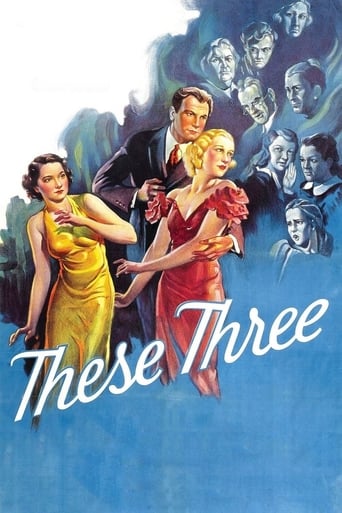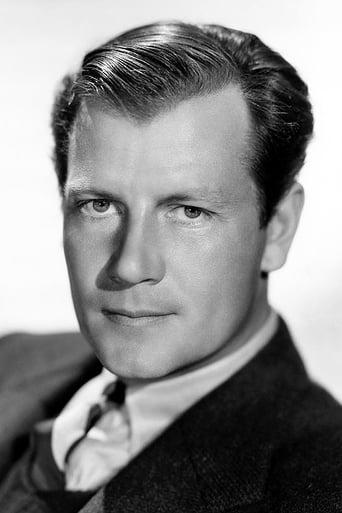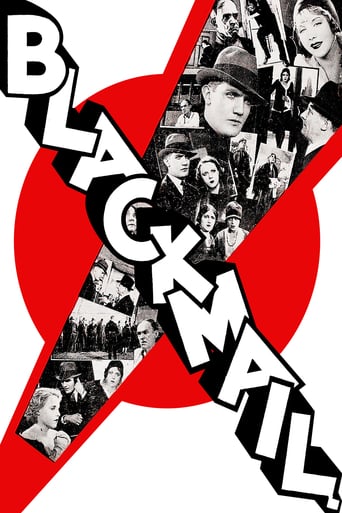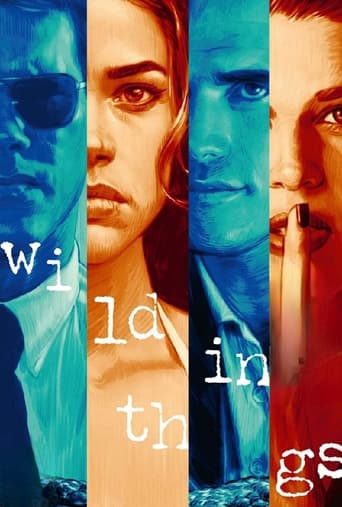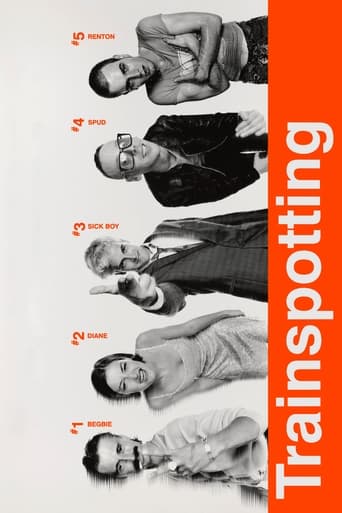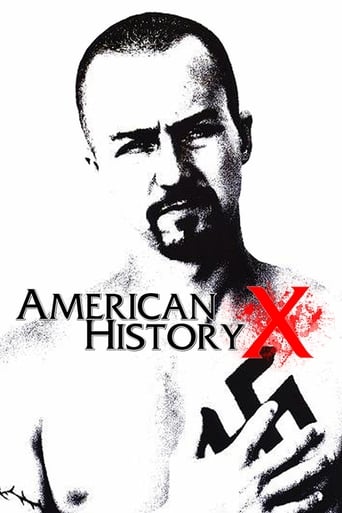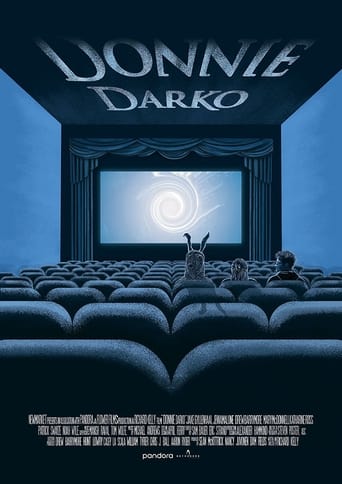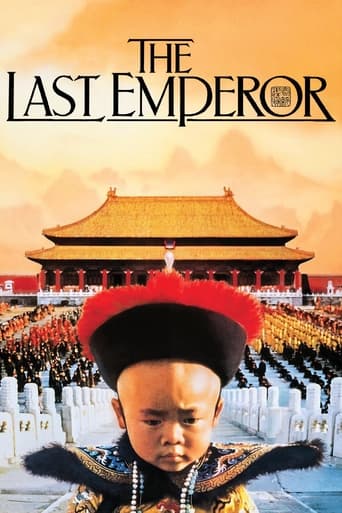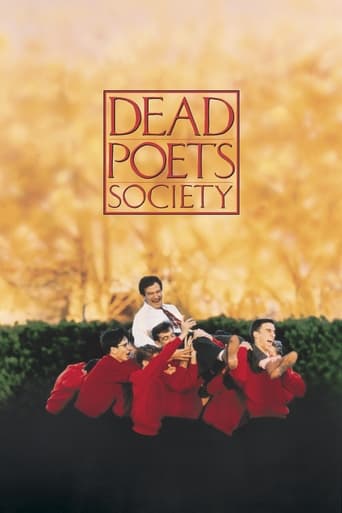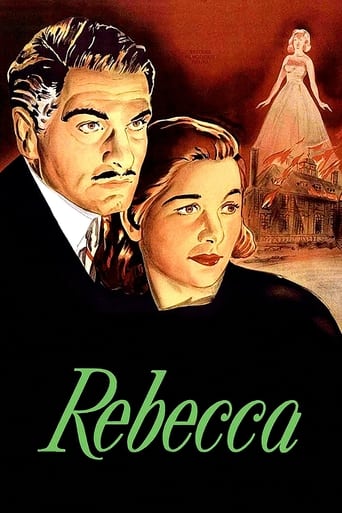These Three (1936)
Martha and Karen graduate from college and turn an old Massachusetts farm into a school for girls. The friends are aided in their venture by local doctor Joe Cardin, who begins a relationship with Karen, and a prominent woman whose granddaughter, Mary, later enrolls in the new school. Mary soon reveals herself to be a spiteful child and tells a scandalous lie about Martha and Joe that threatens to destroy the lives of all involved.
Watch Trailer
Cast


Similar titles
Reviews
i must have seen a different film!!
It's a movie as timely as it is provocative and amazingly, for much of its running time, it is weirdly funny.
The tone of this movie is interesting -- the stakes are both dramatic and high, but it's balanced with a lot of fun, tongue and cheek dialogue.
Worth seeing just to witness how winsome it is.
The "these three" of the title is a pretty mundane triangle with only Miriam Hopkins excelling as the sensitive Martha, caught up in a love affair between her dear friend Karen (Merle Oberon) and husky he-man, Dr. Cardin (Joel McCrea). What this film is remembered for are the spellbinding performances of the two young girls. Psychotic Mary Tilford was played by Bonita Granville who had been around since the early 30s, playing in films like "Silver Dollar" and "Cavalcade" (1933). Nothing prepared anyone for her knockout performance as Mary Tilford, a school yard bully supreme, who rules the weaker Rosalie (Marcia Mae Jones) through fear and intimidation. If anything Jones' portrayal is even more dynamic, as her Rosalie is pushed to the breaking point by being forced to betray a teacher she loves.Karen and Martha, friends and graduates of the same class, plan to set up a school in an old farm house that Karen has inherited. On their first day they meet charming Dr. Cardin and he is instantly attracted to Karen - shy Martha is also drawn to him. They also meet Mrs. Tilford, the most influential woman in the village - she is bringing her grand- daughter, Mary home from school (has she been expelled???) and suggests her as a pupil for their school. Mary becomes the school cheat and bully, singling out sweet Rosalie for her vicious attacks. Mary is fed up with what she feels is unfair treatment and runs away. She concocts a lie about the two teachers and Dr. Cardin and she tells her grandmother so she won't have to go back. The lie gets out of hand as Mrs Tilford is horrified and spreads the news around the town - suddenly parents are withdrawing their children from school and Karen and Martha don't know why!!! To clear their name they issue Mrs Tilford with a libel suit but, unfortunately, Mary is blackmailing Rosalie over the alleged theft of a missing bracelet, so she backs Mary's story and the teachers lose their case!!The power of both the children's performances is extraordinary. Marcia Mae Jones' Rosalie more than matches Bonita Granvilles' Mary in intensity and passion. By the end of the thirties Granville's roles were a far cry from Mary Tilford and she is remembered today for starring in a series built around that all American girl detective Nancy Drew. Marcia Mae Jones, who had been acting since she was a baby (her first role was as a baby in Dolores Costello's "Mannequin"(1926)) played memorable parts in 2 Shirley Temple movies (Klara in "Heidi" (1938) and a particularly horrible schoolgirl in "The Little Princess" (1939)) but nothing else of note. I think Miriam Hopkins portrayal of inhibited Martha is streets ahead of Merle Oberon' bland Karen but when the film was released they both received equal praise. Samuel Goldwyn, who thought this film would provide Miriam with the breakout role she needed, lost interest in her after this.Highly Recommended.
This engaging, often very powerful drama was director William Wyler's first big success. While Lilian Helman's controversial play "The Children's Hour" was censored of lesbian themes due to the Production Code, and made into a triangle drama of two women in love with the one man, this is still a marvellous adaptation. It's a compelling, frightening look at how lies and suspicion can ruin several lives. The three leads are Miriam Hopkins, Merle Oberon and Joel McCrea. Oberon was never much of an actress but she was usually passable enough on screen, and here she outdoes herself, thanks to a good director and meaty material. McCrea is her fiancé that she suspects is having an affair with Hopkins, and he too turns in solid work. Hopkins gives a subtle performance that rises to a fever pitch as the accusations fly. However, it's Bonita Granville's poisonous schoolgirl who tells the lie who is truly unforgettable. Her Mary is surely one of the most spiteful little creatures ever put on screen. When Margaret Hamilton slaps her, I bet everyone would applaud! And this is from an actress who was best known as The Wicked Witch Of The West! Wyler worked with cinematographer Gregg Toland in this film as he would in the later "Wuthering Heights", "The Little Foxes" and "The Best Years Of Our Lives", and it's fair to say they work dramatic magic together. Toland was developing his famed deep-focus here, and the "triangle composition" within the shot works very well. Overall, there's not much to fault. It takes a little while to get into it though.
THESE THREE (Samuel Goldwyn/United Artists, 1936), directed by William Wyler, based on "The Children's Hour" (1934) by Lillian Hellman, who also scripted the original story and screenplay, is a powerful drama expertly transferred to the screen with a timely message on how a spiteful teenager's lies can virtually destroy the lives and reputations of innocent people. Being more like something commonly depicted in 1950s cinema such as THE BAD SEED (1956) for example, THESE THREE can be categorized as ahead of its time.The story revolves around best friends Martha Dobie (Miriam Hopkins) and Karen Wright (Merle Oberon), first presented as classmates graduating from college. While Karen has no living relatives, Martha has her meddlesome aunt, Lily Mortar (Catherine Doucet), a former actress who theatrical manner gets on her nerves. Following their ceremony, the girls decide to work together as teachers by forming their very own school. Taking an old abandoned farm house in Lancet, Massachusetts, Karen has inherited by her late grandmother, they, with the help of Joseph Cardin (Joel McCrea), their neighboring doctor, beekeeper and handyman, help turn a run down building into an established Wright and Dolbie School. The teachers successfully acquire the much needed students to get themselves established. All goes well until Mary Tilford (Bonita Granville), a mischievous child of a rich aunt (Alma Kruger) creates trouble for those around her. Aside from stealing a bracelet belonging to Helen Burton (Mary Louise Cooper) and placing the blame on the innocent Rosalie Welles (Marcia Mae Jones), she fakes heart attacks so not to be punished for her actions, though both Karen and Martha through her as a compulsive lier who needs help and strict discipline. Hearing rumors involving "these three" are enough for Mary to avenge herself on them by stretching the truth out of proportion to her aunt, forcing Rosalie to back up her statements. With Martha and Karen finding their pupils being taken out of school, and the doctor losing his position in the hospital, "these three" join forces in a courtroom battle, to only find their lives and reputations ruined beyond repair.While the screen adaptation substitutes a romantic triangle over its original premise of Martha and Karen as suspected lesbians from the stage play, the film retains its powerful impact thanks to William Wyler's direction. When Wyler directed its remake, THE CHILDREN'S HOUR (1961) starring Audrey Hepburn, Shirley MacLaine and James Garner (along with Miriam Hopkins in the Doucet role), the story was not only brought up to date, but the lesbian theme retained. Comparing both versions, the original is no doubt the best of these two. Although the remake is well acted by the leading players, THE CHILDREN'S HOUR comes off as dreary, depressing and weakened by the lackluster performances by the children, especially Karen Balkin whose tantrums and outbursts can't parallel towards Granville's Academy Award nominated (supporting category) performance as the spiteful Mary Tilford. Before Granville played the lovable teenage sleuth Nancy Drew in four installments for Warner Brothers (1938-39), and other notable roles through her adulthood, she did a similar Mary Tilford portrayal in MAID OF SALEM (Paramount, 1937) as a vengeful girl whose spiteful lies lead to a Salem witch hunt. She proves herself a fine, intense young actress, especially when her motionless eyes show no remorse for her actions.Considering Hopkins and Oberon as possible contenders as Academy Award nominees, Hopkins is most notable as the stronger of the two due to her forceful performance. Aside from keeping her emotions to herself over the man she loves, her heated arguments with her aunt, after refusing to testify for her in court, are realistically done. It seems interesting how the script constantly substitutes "Be still" for either "Be quiet" or "Shut up!" While Hopkins, Oberon and McCrea are the only actors with their names presented in the opening credits, the supporting players, consisting of Walter Brennan who provides the film's lighter moments as a taxi driver who charges a dollar a mile; and Margaret Hamilton as Agatha, the Tilford Maid, in a brief but striking performance with the unruly child, are given the credit they deserve along with other members of the cast. The closing credits does not exist in the old 1986 VHS recording, though available in TV prints. Aside from presentations on commercial TV prior to 1990s, THESE THREE did have exposure on cable television throughout the years, ranging from Turner Network Television (1991-92); American Movie Classics (1992-1993); and Turner Classic Movies (2003-2005).In closing, THESE THREE is another great movie from the Samuel Goldwyn archives. Nothing in this 93 minute presentation drags and no scenes unnecessary. (****)
My favorites are actually Cary Grant, Ingrid Bergman, Katharine Hepburn and Gary Cooper. So having These Three as a favorite movie may not make sense since none of these stars are in this film. BUT - the film is great - simply put. Joel Macrea, Miriam Hopkins and Merle Oberon were superb actors. And that Bonita Granville - the villainous child - is incomparable.I've watched this movie many times and each time is an experience. Highly recommended. The plot may be outdated, nevertheless ,if you are able to go past that realizing this was afterall done in the 1930's, you will fall for the film like I have.I am a big, big old movies buff - the black and whites...This film is one of the reasons why I'm partial to those bygone years.

